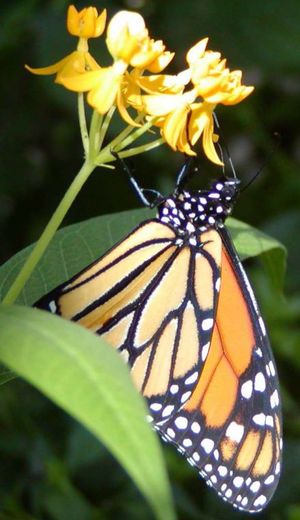Native Plants are Nature’s Intended

The leaves of the native milkweed provide a place for the monarch butterfly to lay its eggs, as well as providing a source of food for larvae that hatch.
“Go native!” sounds like a tropical chant, but actually it’s a “go green” reminder for landscape designs. Native plants are the species of perennials, shrubs and trees that occur in the region where they evolved. They’re the flora that nature intended for the area, and what native insects, birds and wildlife rely on for survival.
“If we want to preserve wildlife, we have to have natural areas and native plants,” said John Hayden, professor of biology at University of Richmond.“For example, right now there’s a lot of interest in bird populations being happy and healthy, but we’re not going to have them without native plants at the base of the food chain.” Hayden said that native plants, insects and animals co-evolved over time, so certain essential interrelationships developed. When native flora is not available or is negatively impacted, ramifications occur across the entire food chain.
Another benefit of using native plants is the need for less. Native plants require less work, less money, less chemicals and less water to maintain than non-natives because they’ve adapted to the region’s soil and climate. There’s minimal or no need to change local conditions to meet their needs.
The growing plea from native plant societies, water-quality organizations, researchers and biologists is to opt for native species whenever feasible—but along with that philosophy comes the need for changed expectations. Native perennials, shrubs and trees aren’t as predictable in size and shape as genetically altered hybrids. They also may not be the newest, largest or most unusual specimens, like some of the genetically enhanced hybrids. However, native plants naturally showcase the region’s native flora and, more importantly, earn the approval of native insects, songbirds and wildlife that make it their home.
If you want to grow native plants, it’s best to purchase them from retailers and nurseries that specialize in native varieties. Those growing naturally in woodlands and meadows don’t respond well to transplanting.
Native plants may be seen and enjoyed along the Garden’s Wildside Walk and Butterfly Meadow, as well as areas of the Children’s Garden.
For tips on nurturing them once planted, explore resources in the Lora M. Robins Library at Lewis Ginter Botanical Garden or these books from the Garden
Shop: “Native Alternatives to Invasive Plants,” “Bringing Nature Home” and “Great Natives for Tough Places.”
Editor’s Note: This article first published in the Richmond Times-Dispatch, in April 2012.